Wood Rates: How Wood Products Stack Up in Green Building Systems
Green building rating systems credit wood, but do not recognize its full potential as a sustainable building material.
![]() Continuing Education
Continuing Education
Use the following learning objectives to focus your study while reading this month’s Continuing Education article.
Learning Objectives - After reading this article, you will be able to:
- Discuss the sustainable aspects of wood.
- Describe how wood receives credits in green building systems.
- Articulate the importance of life cycle analysis.
- Communicate emerging trends in recognizing wood's sustainability.
The choice of wood as a green building material is intuitive. Not only does it grow naturally, it's renewable and is completely recyclable. Wood is an effective insulator and uses far less energy to produce than concrete or steel. It can also offset climate change, since trees consume carbon dioxide as they grow, with the resulting products storing carbon for centuries. Wood's natural beauty and warmth have a positive effect in any application and have been shown to generate improved productivity and performance in schools, offices and better patient outcomes in hospitals.
With all these attributes, wood might be thought of as a major credit earner in today's green building rating systems. But, according to a 2010 study by the Light House Sustainable Building Centre in Vancouver, BC, an average of only 20 percent of credits in commonly used rating systems relate to wood and, while residential ratings systems favor wood, in non-residential systems it is slightly easier to gain points by using other building materials. This article will examine how wood is covered in several key rating systems, as well as ways in which wood's green potential has gone under-recognized. Discussed, too, will be possible changes - including adoption of life cycle analysis and environmental product declarations - in the way rating systems view wood as they continue to evolve in the face of growing awareness of how buildings impact carbon emissions, resource depletion and eco-system degradation.
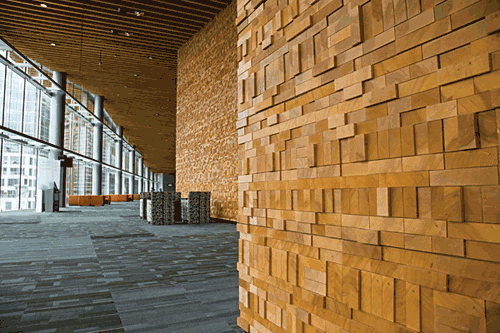 |
The Vancouver Convention Centre's West Building has become an iconic landmark that showcases interior wood design. Photo: www.naturallywood.com |
Wood is Good
Wood is an abundant, affordable and renewable natural resource, and when sourced from well-managed forests, it can be environmentally benign, as well. Strength for strength, wood uses less energy to produce than concrete or steel. Wood's inherent environmental merits include its material efficiency related to its combined thermal mass, as well as its water resistance, structural integrity and finish quality. Clean wood waste is easily recyclable. Add to these attributes the fact that wood can offer habitat restoration and eco-system well-being, support for local economies and contribution to carbon neutral/positive building.
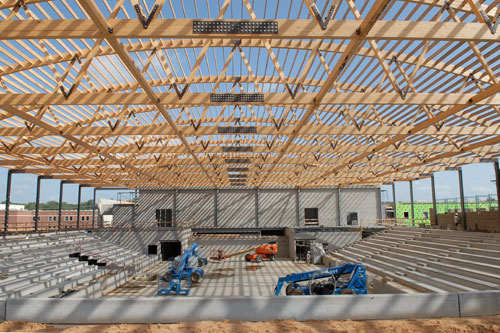 |
Switching from the initial steel and masonry design to wood construction reduced the cost by $2.7 million (US). El Dorado High School, El Dorado, AR. Architect: CADM Architecture, Inc. Photo: WI Bell, courtesy WoodWorks |
Timber, in fact, is known for its ability to store carbon, giving it an environmental advantage over other construction materials with their energy-intensive production processes. Producing building materials such as steel, cement and glass require temperatures of up to 3,500 °F. In contrast, forests with healthy ecosystems are virtual carbon sinks by removing carbon dioxide (CO2) from the atmosphere. In the process of photosynthesis, all parts of the tree - trunk, branches, leaves, and root systems - store carbon in the form of sugars, releasing oxygen back into the atmosphere. While trees that die and decompose in the forest release carbon as CO2 back into the atmosphere, no more carbon is emitted in the production and whole life cycle of a wood product than is absorbed from the atmosphere when the tree is growing. Timber that ends up as wood products for use in buildings actually stores carbon over the life of the building. At the end of its structural use, it can be deconstructed, salvaged (for more information see www.dontwastewood.com) or used as an energy source, substituting for fossil fuels.
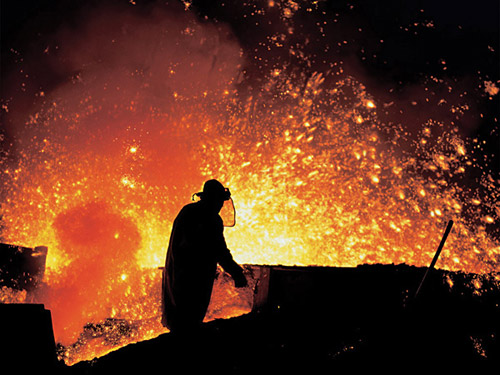 |
The manufacture of many building materials is energy intensive. Photo: Used with permission from Trinec Iron and Steel Works (Trinecké zelezérny) |
How Wood is Currently Rated
The Light House Sustainable Building Centre study commissioned by Forestry Innovation Investment examined the ways in which the world’s major green building rating systems incorporate wood, pinpointing where the ecological value of wood products was most recognized. Systems surveyed include: BREEAM, Built Green™, CASBEE®, Green Globes™, Green Star, LEED®, the Living Building Challenge, NAHB Model Green Home Guidelines, and the SB Tool. As several systems such as LEED and Built Green offer a range of applications for specific building types, a total of 18 applications were assessed. All systems are voluntary and unregulated.
| Systems Studied | |
BREEAM. The UK-based Building Research Establishment's (BRE) Environmental Assessment Method for offices, multi-family residential and ecoHomes offers credits in ten categories according to performance which are then added together to produce a single overall score on a scale of Pass, Good, Very Good, Excellent and Outstanding. Established in 1990, BREEAM is the basis for most other rating systems and with more than 100,000 certified buildings, it is the world's most widely used green building rating system. Built Green™ A voluntary program for residential construction, Built Green was started in the U.S. by home builders. In Canada, owned and managed by the Built Green Society of Canada, this system is open to members of participating Home Builders' Associations and offers certification for new single-family homes and row homes, and a pilot in multi-story residential. CASBEE® (The Comprehensive Assessment System for Building). Japan's green standard uses building environmental efficiency (BEE) as a basis for assessment by dividing the building environmental quality and performance by the building environmental loads. Developed by a committee under the initiative of the Ministry of Land, Infrastructure and Transport in 2001, the system has sequentially developed various categories including new construction, existing buildings and renovations. Green Globes™. In the U.S., Green Globes is owned and operated by the Green Building Initiative which, in 2005, became the first green building organization accredited as a standards developer by the American National Standards Institute (ANSI), and began the process of establishing Green Globes as an official ANSI standard. In Canada, the federal government uses the Green Globes suite of tools and it has been the basis for the Building Owners and Manufacturer's Association of Canada's (BOMA) "BESt" program. Green Globes is a web-based tool that provides feedback on how to reduce operating costs and environmental impacts of commercial projects based on input from the design team. Third-party certification of the site results in a higher rating. |
Green Star. Australia's green standard launched by the Green Building Council of Australia in 2003. Since then, a variety of Green Star rating tools have been developed from multi-unit residential to retail, office, and office interiors. There are currently similar programs in New Zealand and South Africa. LEED® (Leadership in Energy & Environmental Design). The U.S. green building certification program was developed by the U.S. Green Building Council and provides third-party verification that a building or community was designed and built using strategies that improve performance in the following areas: energy savings, water efficiency, CO2 emissions reduction, stewardship of resources and sensitivity to their impacts, and indoor environmental quality. LEED rating systems are tailored to various market segments. LEED version 3 was launched in 2009. LEED is increasingly in use in other countries such as Canada, China, India and Mexico. Living Building Challenge. This program of the Cascadia Green Building Council is mainly active in the US and Canada and is meant to be the next step after LEED Platinum and a step before regenerative buildings. Intended "to define the highest measure of sustainability attainable in the built environment based on the best current thinking - recognizing that 'true sustainability' is not yet possible." No project has yet to incorporate all facets of the program. NAHB (National Association of Home Builders) Model Green Home Guidelines. Published in 2005, these guidelines, now part of NAHB's National Green Building Program, include the ANSI approved ICC-700-2008 National Green Building Standard. They are the basis for the Green Scoring Tool, and can also function as the foundation for local organizations' green building programs.The SB Tool. This software implementation of the Green Building Challenge assessment method has been under development since 1996. Initially launched by Natural Resources Canada, the process is now the responsibility of the International Initiative for a Sustainable Built Environment. |
Generally, every rating system offered a certain percentage of credits that could be achieved with the use of wood. In most cases, wood is recognized by rating systems in the following areas:
Certified wood. Most rating systems give credits for wood that has been certified by a respected third party verifier as coming from a sustainably managed forest. Different rating systems allow for different certification schemes, with some more inclusive than others. While rating systems reward projects that use certified wood, they do not hold competitive materials such as concrete or steel to the same level of accountability, nor penalize them for failing to achieve a similar standard.
Recycled / reused / salvaged materials. Many rating systems give credits for recycled content, though only some allow salvaged wood to count towards this credit.
Local sourcing of materials. Most rating systems credit use of local materials, though the intent differs and ranges from supporting the local economy to reducing the environmental impacts from transportation. "This makes sense on an intuitive level since less energy will be required to transport the materials," writes Wayne Trusty, President of the Athena Institute, a non-profit organization that seeks to improve the sustainability of the built environment through better information and tools. "But there are a tremendous number of factors that influence whether or not a material produced locally is better for the environment, including the sources of its components, type of manufacturing process and mode of transportation. So, in fact, using locally-produced materials could either add to or detract from a building's sustainability."
Some rating systems use local content credits with the intent of rewarding lower embodied energy and/or life cycle emissions, when in fact a life cycle analysis approach may be more appropriate. Rather than placing a travel distance limit for sourcing the material a more rigorous approach would be to have separate credits for local resources and embodied energy, as is done in Japan's CASBEE.
Building techniques and skills. Rating systems that focus on low-rise residential homes tend to be less performance-based and more prescriptive standards than those for commercial buildings, and frequently prescribe specific building techniques, such as advanced framing that reference wood.
Waste minimization. Many systems credit diversion of a certain amount of construction waste, or for minimizing wasted woodcuts. Architects may want to confer with builders on how to earn points by implementing certain job site protocols in order to leverage their use of wood in green building credits.
Indoor air quality. Most rating systems demand that all wood adhesives, resins, engineered and composite products contain no added urea formaldehyde and have strict limits on VOC (Volatile Organic Compound) content. While many products (such as carpets), have created clear guidance to specifiers about their toxicity, information about wood products (particularly panel products such as plywood and MDF) can be less straightforward, compounded by challenging tracking and quality control systems.
The study found that the prevalence of wood varied by rating system. Rating systems for single family homes in North America were the most inclusive of wood products: 25 percent of all credits in Built Green Canada for Homes involved the use of wood. Rating systems for commercial buildings and buildings outside of North America were the least inclusive: less than 10 percent of the credits in SB Tool, LEED NC US, and BREEAM Code for Sustainable Homes related to wood. In rating systems for commercial buildings, between 8 percent and 18 percent of the total credits related to wood, with LEED CI at the top of the range.
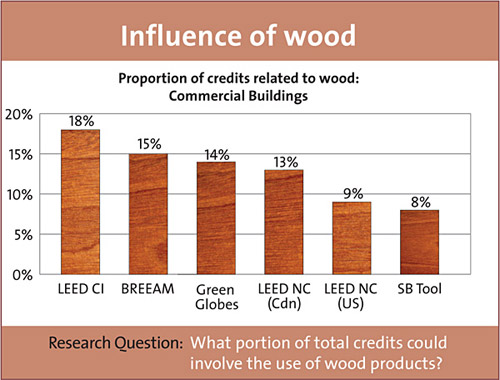 |
|
Source: Light House Sustainable Building Centre |
The use of wood helped achieve six points in Canada's first LEED Platinum certified building, the Operations Center at Parks Canada's Gulf Islands National Park Reserve. The reserve, which includes 15 islands and inter-tidal areas between Victoria and Vancouver, British Columbia, completed its Operations Center in 2005. The use of Canadian Standards Association-certified (PEFC-endorsed) wood garnered points for the use of wood materials from local sources. Indigenous species were used for both finishes and structural application. Western red cedar, which has a strong historic and cultural importance locally, was used extensively for exterior cladding and sunscreens and finished with a water-based, clear finish that serves as a water-repellent shield and protects against ultra-violet (UV) degradation. Inside, cedar slat walls define the central stair and accent walls in other rooms. Douglas fir was used in glulam beams and columns that provide main structural support, and edge-grain Douglas fir for window and doorframes, casings and trim, and for the structural decking in the second-floor walkway bridges.
Wood finishes and structural members were finished with clear, water-based finishes with VOC content. In millwork and wood doors, clear birch veneer was used over formaldehyde-free substrates. Minimizing VOC emissions from all wood products - plywood, medium density fiberboard and solid core doors included - gained a point under indoor air quality. Though not eligible for LEED points, wood was the only structural and finish material that comes from a renewable resource. "The mandate of our client, Parks Canada, is the preservation of Canada's National heritage sites and they wished to demonstrate this commitment in their Operations Centre through the selection of sustainable/renewable building materials," says Larry McFarland, FRAIC, MAIBC, Principal, McFarland Marceau Architects Ltd., Vancouver, British Columbia. "Although LEED is a measuring device, it does not yet recognize the true environmental input of various construction materials of which wood is the only renewable one. We have not used other green building rating systems but advocate that all building materials should be held to the high level of accountability to which wood is subjected.
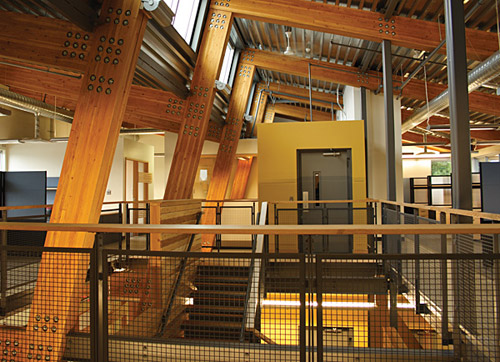 |
Wood helped the Gulf Island National Reserve Operations center to achieve LEED Platinum status. Photo: Derek Lepper |
How Wood Impacts Rating System Scores
To understand the extent to which the use of wood aids or hinders rating system success, the study compared two theoretical projects in which the intensity of wood use was changed but all other considerations were held constant. In one "high intensity wood" project, wood is specified wherever possible. In the other "low intensity wood" project, other products are used in lieu of wood - selected based on their ability to maximize rating system point success. Several caveats applied. The assumption was that all wood-related credits would be achieved, regardless of cost or complexity - a scenario that is virtually impossible in reality. Some certified products are more difficult to specify than others, such as certified heavy timbers; some strategies are technically difficult or prohibitively costly to achieve; and some are challenged with regulatory constraints, including the use of wood in non-combustible construction. In addition, some systems could not be compared due to the integrated nature of the rating system and the structure and scope of the materials credits, as in Green Star and Living Building Challenge.
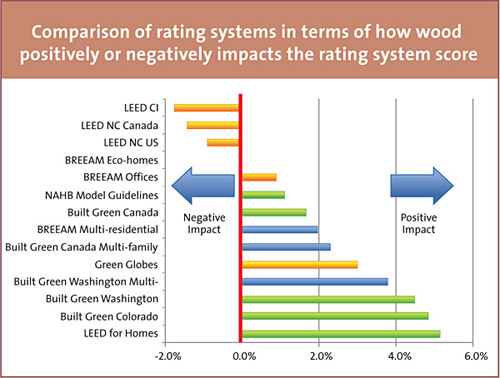 |
|
Source: Light House Sustainable Building Centre |
Caveats notwithstanding, the analysis found that while the intensity of wood used in a project did not have a large impact on the number of total credits that can be achieved, it was clear that certain rating systems are more "wood-friendly" than others. Rating systems for single family homes such as Built Green were most predisposed towards wood, while commercial building systems such as LEED (U.S. and Canada) made it slightly easier to score points by not using wood. "Rating systems have become the definition of energy efficient and environmentally responsible building, and that represents a limited view," says Helen Goodland, Executive Director of the Light House Sustainable Building Centre. "Yet rating systems are continually evolving. How wood is considered is surely an area of interest to be explored."
Wood's Unrecognized Assets
"Wood can help designers create greener buildings, yet we found that wood's most significant ecological benefits - that it is the only carbon neutral construction material and that it can significantly reduce a building's life cycle impacts - are largely unrecognized by the most commonly used rating systems," says Goodland. She notes that there are gaps in most rating systems in areas where wood may play a positive role, including acoustical performance, life cycle analysis and material efficiency.
Yet even the attributes that go under-recognized by the rating systems, are not entirely ignored by architects themselves. Case in point is the Richmond Olympic Oval, home to long-track speed skating during the 2010 Olympic and Paralympics Winter Games, which achieved LEED Silver and Green Globes certifications.
The Oval features a roof structure built almost entirely from wood, both glulam beam arches and an unprecedented prefabricated system of "wood-wave" structural panels. This roof, which is one of the longest wood clear spans in the world, includes a roof deck consisting of one million board feet of conventional lumber linked together in undulating sections to create a coffered visual effect. Designed by structural engineers Fast + Epp and constructed at the design-build firm StructureCraft Builders Inc. in Delta, British Columbia, the roof evolved from what has been described as a "kitchen table idea," to a sophisticated design that was calibrated by complex computer models to test the load-bearing properties, subsequently modified and real life prototypes built.
Two roof options were developed during design. The roof size and shape of each option was virtually identical. The first option was constructing the roof from conventional steel trusses and acoustic steel deck. This was the "default" option. The second option was the "wood-wave" roof system which is a custom roof assembly consisting primarily of standard lumber with integrated building systems. The wood-steel arches are triangular-shaped and hide mechanical, electrical and plumbing equipment. Some 452 prefabricated wood wave panels span across the 15 enormous glulam arches. They are built of ordinary softwood 2x4s fastened together in a wave-like form. The designers distributed the pattern of the deck lumber to allow for structural mass reduction, aesthetic interest and acoustic absorption through the interior attenuation blankets.
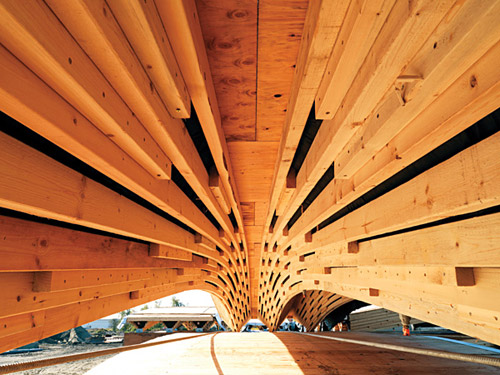 |
Richmond Olympic Oval received LEED Silver and Green Globes certifications. Photo: www.naturallywood.com |
As in any large space, acoustical performance was very important. "The acoustic performance criteria were established in relation to the acoustic performance of the perforated acoustic steel deck. The 'wood wave' had to demonstrate acoustical performance at least as good as this 'default' option,'" says Robert J. Johnston, AIA, Principal National Sport Practice Leader, Cannon Design Architecture Inc. in Victoria, British Columbia. "This was demonstrated to be the case. The acoustic separation properties were at 1.85 (to steel deck at 1.00) and the attenuation performance was at 1.15 (to steel deck at 1.00)."
While acoustics is an important part of any building seeking higher standards in indoor environmental quality, most rating systems ignore acoustical performance completely. In fact, of the systems surveyed in the Light House study, only Green Globes refers specifically to acoustical performance. Goodland calls that unfortunate, citing the fact that early post occupancy studies of green buildings show that acoustical performance tends to be below expectations. "Wood panel products and products containing wood fiber are particularly useful in sound abatement and control strategies," she says.
Life Cycle Analysis: Getting to a Material's Real Green Quotient
LCA is an objective methodology of comparing materials or even entire structures over the course of their lifetime from resource extraction through manufacturing, distribution, use and end-of-life disposal. Although ISO 14040 provides a recognized LCA methodology, according to the study, the life cycle benefits of wood are not widely considered in the rating systems: only six of the 18 systems surveyed recognized wood's life cycle benefits, among them, Green Globes in North America. LEED currently has LCA as a pilot credit, with a decision as to whether it will be fully incorporated expected in 2011.
"The primary environmental benefit of wood, its low carbon footprint, is under-recognized, particularly in North American rating systems," says Goodland. "Yet considerations of life cycle analysis and the embodied energy of materials are critical considerations in the design of an environmentally responsible building."
It can also be said that at this time calculating life cycle impacts is complex and time consuming, the outputs hold little value to clients given the lack of inclusion in green building policies or in rating systems. Currently, according to the report, "only a few of the rating systems quantitatively and holistically address life cycle impacts of materials and of those, there is sometimes little follow-through from the calculation to the building project itself."
That said, use of LCA is on the rise in evaluating the environmental impacts of building materials such as wood, steel and concrete. Substantial work is underway to develop robust LCA data, principally by the University College London, the Consortium for Research on Renewable Industrial Materials (CORRIM), and the Athena Sustainable Materials Institute. To date, studies overwhelming confirm that wood buildings produce less air and water pollution, require less energy across their life cycle, and generate less CO2 emissions than alternative materials. Landmark research by CORRIM found wood to outperform alternative materials in studies using LCA to compare homes framed with wood and steel in Minneapolis and homes framed with wood and concrete in Atlanta. Research indicates that homes framed in steel and concrete required 16 to 17 percent more energy respectively (from extraction through maintenance) than the wood-frame homes. The global warming footprint of the steel-frame house was also 26 per cent higher and the concrete-frame house 31 percent higher than the homes framed in wood.
| Salvaging a Casualty of Global Warming |
Architects for the Richmond Olympic Oval have gone the distance for salvaged wood. Millions of acres of forest land have been wiped out by the mountain pine beetle. The tiny insects lay their eggs under the bark. The beetles introduce a bluestain fungus into the sapwood that prevents the tree from repelling and killing the attacking beetles with tree pitch flow. The fungus also blocks water and nutrient translocation within the tree. Because of this infestation, trees which normally capture carbon and release oxygen are now dying and releasing carbon. The beetle attacks and kills lodgepole, ponderosa, sugar and western white pines and is found in a range from the (needs spaces btw the words) Pacific Coast to South Dakota and from northern British Columbia into northwestern Mexico. The situation is particularly acute in British Columbia. It is estimated that almost one quarter of the province's forest land has been affected to some degree by the current outbreak. Normally, cold temperatures, forest fires and natural predators keep populations in check. However, an abundance of mature lodgepole pine, combined with recent mild winters and uncharacteristically hot, dry summers, have led to an unprecedented infestation. A silver lining in this story is that designers are beginning to specify wood that has been affected by the pine beetle. Not only does that make use of resources of dead timber, if incorporated into buildings, wood salvaged from pine beetle infested forests will continue to store carbon and delay the release of carbon dioxide into the atmosphere. The entire "wood wave" roof on the Richmond Olympic Oval is from Spruce-Pine-Fir (SPF) dimension lumber, including mountain pine beetle affected pine stock. "Only some percentage of the entire stock is pine beetle affected," says Cannon's Johnston, explaining that when a forest products company conducts emergency harvests as a result of the infestation, it still mixes the affected pine wood with regular wood. "This is because both sources are virtually identical in structural performance and appearance, and identical to work with." "Such an environmental emergency is typically not recognized in the sustainably harvested wood certification credits." Our "wood wave" panels are an example of innovation in sustainability rather than evidence of sustainably harvested timber," says Johnston. "In our opinion, the designers should be rewarded with credits in addition to sustainably harvested wood when demonstrating this kind of local environmental awareness and responsiveness." Because of its low toxicity, low embodied energy and carbon sequestering properties, the wood makes a significant environmental contribution. Experts peg the total potential carbon benefit of the Oval over its anticipated lifespan is 8,800 metric tons, or the equivalent of taking 1,600 cars off the road. |
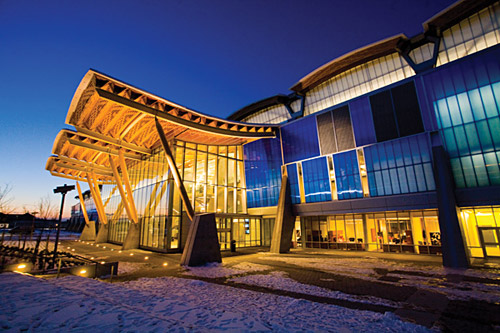 |
Richmond Olympic Oval's roof makes use of salvaged wood. Photo: www.naturallywood.com |
There are suites of tools from eco-calculators and impact estimators that enable architects to test, say, a wood exterior wall vs. a wall built of another building material, and to judge their relative environmental merits. "These tools have been around for years and they just keep getting better and better," says Goodland. "The problem is that at this point there is little motivation for uptake due to lack of rating system recognition."
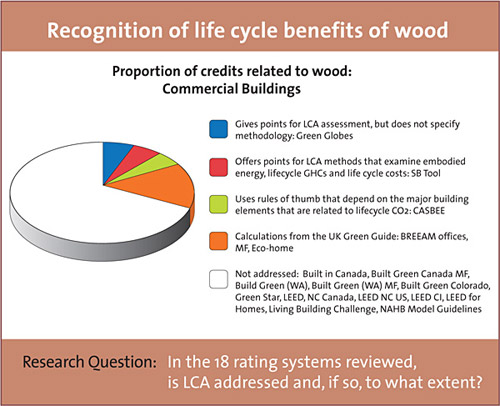 |
|
Source: Light House Sustainable Building Centre |
What the Future Holds
According to the study, much of the headway in documenting wood as a green building material comes from Europe. Strategies that have gained a foothold in Europe have the potential to push the green building industry to greater environmental achievements - and it is likely only a matter of time until they take hold across the pond. "Europe may be the harbinger of future green building activity in North America," says Goodland. If so, increased attention will be paid to the carbon inputs into a building and the product-related carbon information that is available to designers. Emerging strategies to get to carbon-neutral buildings include:
Life cycle analysis as a separate credit. As tools and methodologies become more rigorous and easy to use and the emphasis increases on carbon disclosure and the relative sustainability quotient of competing products, rating systems may adopt LCA as a separate credit. For an early indication, architects are advised to look at whether and how LEED incorporates credits for LCA, as a result of its current pilot program for LCA points.
More quantitative green information. Manufacturers may become more involved in developing the quantitative information to address criteria necessary to achieve specific credits for wood-based products that have recycled content and/or use low-VOC and low/no added formaldehyde. Easy-to-use design guides, structural sizing charts, code interpretations, credit application "cheat-sheets" may be available to help building professionals negotiate their way through the tangle of rating systems and earn credits for the use of wood in residential and non-residential applications.
Environmental product declarations. Environmental product declarations (EPDs) hold out the promise of disclosure of the environmental performance of products in such a way that the consumer can make side-by-side comparisons of different products, much like a nutrition label does. EPDs are far more prevalent in Europe, particularly Germany, France and the UK than in North America. Yet the move to EPDs is picking up steam here too. One example is the Cascadia Green Building Council's Pharos project which aims to provide not a certification but information on critical health and environmental data about the manufacture, use, and end of life of building materials. "Architects should know to ask for this kind of information and put it on their list when they question a manufacturer about products they are interested in specifying," says Goodland. Though currently a fairly complicated moving target, especially in North America, Trusty predicts that in the near future EPDs will be coming on like gangbusters. "There are almost 500 'green' labels out there," he says. "LCA-based systems and EPDs will start to clear that up."
Salvaged wood and the pine beetle. With the extent of mountain pine beetle damaged forests across North America, the salvaged wood may stand to be admissible under salvaged materials credits or through regional priority credits, particularly as it gains a solid track record in LEED (and Green Globes) certified projects. Alternatively, mountain pine beetle killed wood can be considered a carbon storage strategy through a life cycle carbon evaluation.
Passive design. Defined as building design that permits the use of natural processes - convection, absorption, radiation, and conduction - to minimize energy consumption and improve thermal comfort, passive design has made strides in Europe, where Passivhaus Institute administers a rating system defined by energy use intensity targets. Researchers in Europe have identified wood as a suitable material in the development of passive buildings due to its unique combination of properties, including thermal resistance, natural finish, structural integrity, light weight and weatherproof qualities. Awareness and adoption of the principles of passive design are only now taking root in North America and no current rating system directly references passive design strategies, dematerialization or material efficiency. Goodland notes that passive design is beginning to be incorporated in small buildings in North America through the use of structural wood panels. "This enables wood to be considered in the context of the energy and atmosphere sections of rating systems," she says.
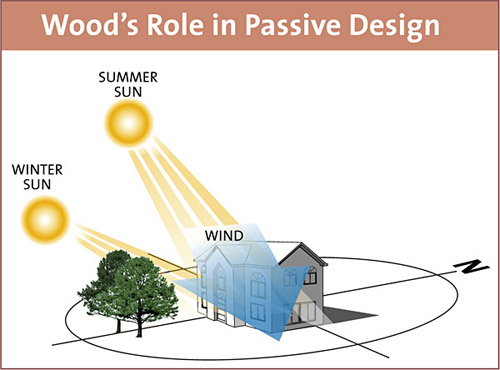 |
Source: "Passive Design Guide for Homes, prepared for the City of Vancouver by Light House Sustainable Building Centre and Guido Wimmers," November 2008 |
Wood fiber insulation. Having made its way into European markets for its thermal performance, low carbon footprint, ease of installation and its well-being when compared to glass fiber batt and urethane foams and boards, wood fiber insulation has a definite advantage that may one day be recognized by the rating systems. "Today, rating systems do not reference material performance in fire, specifically toxicity," says Goodland. "But if they did, wood would be at an advantage compared to, for example, polyisocyanurate board."
An Evolving Situation
The full potential of wood as a genuine green building material with the capability to get to carbon neutrality may well be under-recognized, at least by the rating systems. Those systems dedicated to home building are most favorably disposed to the use of wood, while rating systems dedicated to commercial building are at best indifferent to the prevalence of wood. Goodland calls North American building codes generally too prescriptive (unlike European performance-based codes) so material choices are driven by conventional views of durability. Moreover, current pricing structures do not include the true external costs of products in terms of transportation, raw materials, and the like, and the industry is also constrained by liability issues and risks inherent in innovation.
"Currently designers are not motivated to consider the global warming potential of the materials they choose because there are no regulations, incentives or best practice standards," says Goodland. "But after the Copenhagen Climate Change Summit in December 2009, global policy priorities are shifting to greater awareness of the value of low carbon solutions in the fight against climate change. In the future, builders will almost certainly be held accountable for their building's performance during construction and operation. International building standards will start to align around energy performance and carbon neutrality - and the benefits of wood as a renewable resource with low-embodied energy will play their part."
 |
The reThink Wood initiative is a coalition of interests representing North America's wood products industry and related stakeholders. The coalition shares a passion for wood and the forests they come from. Innovative new technologies and building systems have enabled longer wood spans, taller walls and higher buildings, and continue to expand the possibilities for wood use in construction. www.rethinkwood.com |
